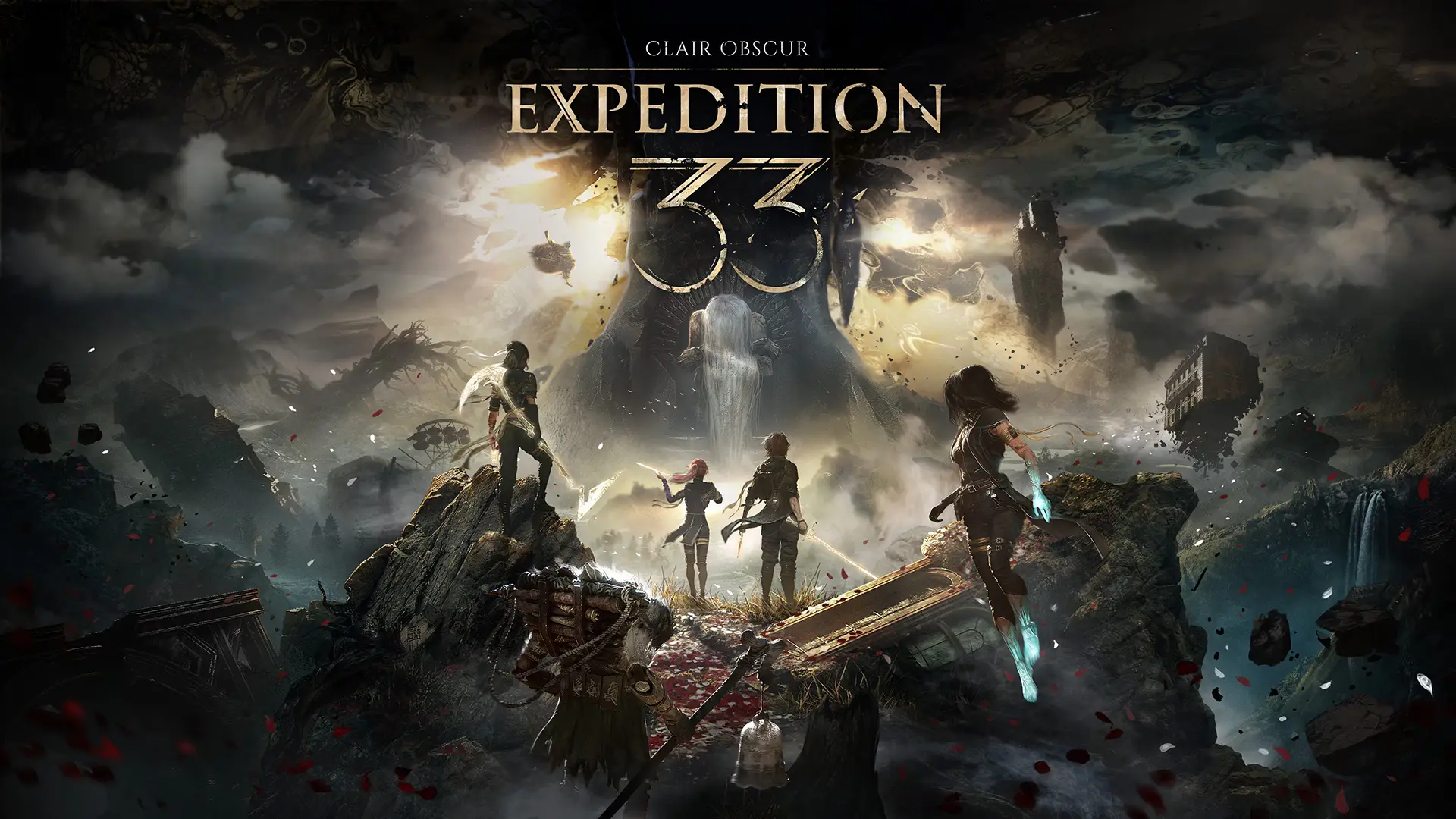Transcribed from the video:
I finished Clair Obscur: Expedition 33 a couple of weeks ago, and honestly it’s taken me a while to process what I experienced. It’s rare for a game to blend combat, visuals, and a narrative that cuts this deep. It tackles stuff like memory, grief, and, well, deeper stuff that I can’t go into in a spoiler-free review. So let’s talk about why this game left me speechless—and why it might stick with you long after the credits roll. Let’s talk about Clair Obscur: Expedition 33.

First, I need to explain that this is an indie game that sort of came out of nowhere, at least for me. By now it’s the stuff of legend, but apparently some mid-tier developer at Ubisoft was bored out of his mind and stuck in a rut in the belly of that beast, and decided break free and start his own studio. He surrounded himself with like-minded talent, but from the sound of it none of them were all that experienced in game development. He met the writer online, like on Reddit or something, and he hired the musical composer off of Fiver.
If you don’t know much about this game, that might not sound that amazing. But believe me when I tell you, this is some of the best writing I’ve seen a video game. And the soundtrack? One of the songs has over 11 million plays on Spotify alone. This is monumental stuff.
Now this team got funding somewhere, because the game features an all-star cast of actors. It stars Charlie Cox of Daredevil fame, Ben Starr from Final Fantasy XVI and a LOT of other stuff, and oh-by-the-way it also stars Andy Serkis and a bevy of other voices you might know from Baldur’s Gate 3, Elden Ring, and that sort of thing. To put it simply, there’s nothing amateur about the final product here.
It’s a turn-based JRPG inspired by series like Final Fantasy and Persona, but it doesn’t really feel like those games, at least not to me. This almost felt like a tactics version of a soulslike game, because there’s a lot of dodging, parrying, and studying your opponents movements and attack patterns. Which is a challenge for me because I’ve never really been a fan of that sort of combat, and I suck at parrying in every game I’ve ever played.
And speaking of me, I need to explain that a few years ago I had never really played a JRPG. For whatever reason, they were never really on my radar back in the 90s and 2000s when these things roamed freely. But more recently, I played Chained Echoes, Final Fantasy VII on the original Playstation, Sea of Stars, Final Fantasy 1, and I’ve dabbled in Persona 5, Chrono Trigger, Tales of Arise, Super Mario RPG, and a handful of others. I just want you to understand that I’m no JPRPG aficionado, but I do have some context in these games.
Now, the hard part. The reason the review for a game this good has taken so long to create is, just where do I begin? Let me start with thing that got me interested in the first place: the premise of the game—because it’s absolutely insane.
The Setup
So, imagine living in a French city that’s been split off from the mainland and dropped in the middle of the ocean. Everything around you is fractured and broken, and across the sea you can see a monolith with a number painted onto it. Each year a giant witch, referred to as the paintress, paints a new number that’s counting down. And on the day that year’s number is painted, everyone who is that age vanishes away like Thanos snapped his fingers. So when your number, your age, is painted on the monolith, you know you have exactly one year left before you too will dissolve away.
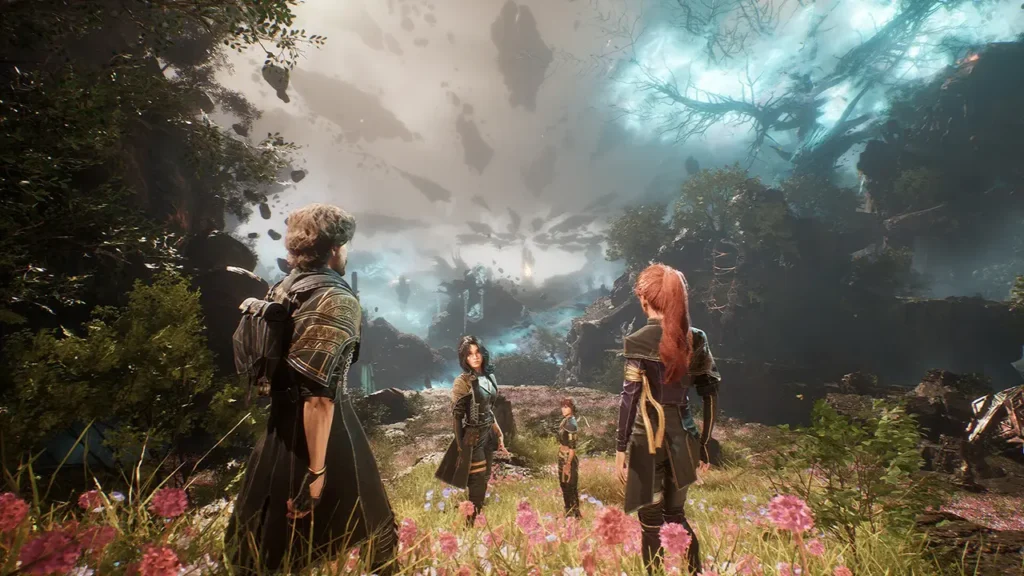
No one on the island knows what happened or who the Paintress is. But they’ve lived their lives here and watched everyone older than them disappear into thin air. Each year, a group of people who know they’re on their last year form an expedition to travel to the monolith to try to figure this thing out.
…and that’s where our story starts. Our hero is 33 years old, and the number 33 has just gone up. It’s his turn to join the expedition and make his way across the sea.
Now, first of all, that’s one hell of a premise. I’d love to hear the elevator pitch for this thing when it was just getting off the ground. Like how do you describe that to an investor? But thing is, gamers get it. I remember seeing this thing when it was announced at the Xbox Games Showcase in 2024 and it felt like a splash of water in the face. In a sea of remakes, reboots, live service games, and yearly releases from stale franchises, this thing was fearless.
It wanted to be as weird and creative as the games that inspired it, and there was no one upstairs to tell them to try to appeal to wider audience, or to stay away from turn-based combat, or to figure out how to cram in micro transactions. Clearly, this game was made by gamers, from the testers all the way up to the c-suite. And the result is a one-of-kind experience.
Story
So the story is breathtaking, and I can’t really say much about it without going into spoiler territory. Side note: if you have anything to say in the comments about the game or this review, I only ask that you don’t put any spoilers in there—this is very important to me. Thanks. I can say that beyond the somewhat bonkers setup, there’s actually a lot of meat on the bones as the story unfolds and the characters develop. Its an emotional story about loss and the grief that comes with that. It’s personal, it’s nuanced, and it’s incredibly thoughtful.

There were different points in the game where I felt like I just needed to put the controller down and absorb what had just happened. When I finished the game there was a lot to process, and the next day I actively sought out other players that had finished the game to talk about it. I hadn’t felt that way about a game since Cyberpunk and probably only a handful of times before that. I actually feel like some of the themes from Cyberpunk and Clair Obscur overlap a little, which is fascinating to me, but this isn’t the time to talk about that.
So Clair Obscur is a French term in art for basically a lot of contrast between light and dark. And that’s a theme we’ll reference a lot here, starting with the fact that in addition to the story being emotional and thoughtful, it’s also… overwhelmingly… brutal.
Combat
Death hangs over the team in every step of the expedition, and the only way to advance is to destroy. There are signs of death everywhere, and there’s one zone early on that’s literally piled high with corpses. But you have the tools to fight back, including equipment, skill sets, and abilities called Pictos.
For equipment, there’s really only weapons to deal with, and each team member uses a unique weapon type, so it really simplifies equipment management. Every few levels or so, you’ll either discover a newer, better weapon or if you already have a favorite you can use resources to upgrade them along the way.
Each character has a skill tree with dozens of skills to choose from, but only a handful can be equipped at any given time. Some skills for one character may compliment skills in someone else’s skill tree, so finding those synergies can go a long way and really make your team lethal.
Lastly, you have abilities you can pick up along the way, and these are called pictos. Each pictos has some sort of offensive or defensive advantage, and each expedition member can equip a certain number of pictos. It’s a little complicated, but each pictos can be used by other team members once you’ve won enough battles with that particular one. Only now they’re referred to as Luminas. Close up of me deep in thought. Yeah, I think I said that right.
So the combination of weapon abilities, skill sets, pictos, and luminous becomes a really engaging way of crafting your own mix bonuses and abilities that compliment your play style. For me, I found one character to be a particularly good healer, another a tank, and others as hard hitting as I could make them. You can only go into battle with three members at a time, and I routinely switched out my team for different situations. But I usually had two heavy hitters and a healer.
In case you’re wondering, yes your bench players do level up when they’re not on the battlefield, just not as fast. So it’s worth it to have a rotation of sorts to keep everyone leveled up and useful.
Ok, but here’s the cool part. This game is turn-based, and when you’re attacking there’s an opportunity to press a button in a standard quicktime event to make your attack hit harder. And when you’re on defense you have to determine when to dodge, parry, or jump depending on the attack. Dodging has a larger reaction window, but a successful parry gets a free counter attack. There’s also another move called a gradient counter, but the important thing is that with every attack, you have to be on your toes and ready to react accordingly.
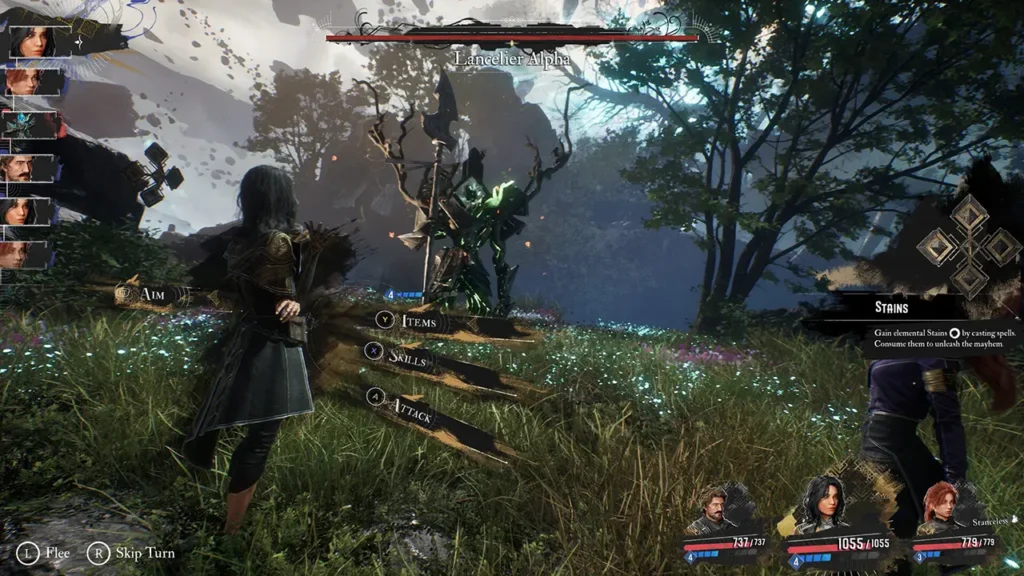
The end result is a combat system that is cerebral and tactical, but it’s also incredibly visceral and intense. And I know what some of you are thinking: there are JRPGs that have been doing this for decades, whether it’s timed attacks in Super Mario RPG or parrying and dodging in games like Ys or the Tales Of… series. This is all true, and no I haven’t played all those games. But I think it’s safe to say no one has brought all those different systems together like this. Learning an attack pattern, pulling of the perfect parrying, setting up a huge hit, and then pulling it all off is satisfying in a way I can’t really capture.
So can you enjoy this game if you suck at parrying? I’m living proof that you can, and I actually have a short about just that, so be sure to check it out if your dodging and parrying is as dodgy as mine. While you’re at it, check out my channel and even subscribe if it looks like a good time. And don’t forget to like this video so YouTube knows it doesn’t suck. Hopefully. I work hard at presentation, but not nearly has hard as Sandfall Interactive.
Presentation
The whole thing is presented in a beautiful, painterly aesthetic that feels like a moment of clarity on the edge of insanity. Everyone is behaving in a mostly logical way to events that are increasingly illogical. And that brings us back to that theme of extreme contrast. While having a conversation about trauma and the stages of grief, you might find yourself talking to a giant balloon or a guy that looks like a toupee in overalls. You can go into battle wearing blood-soaked combat attire, or you can, I dunno, wear a beret and have a giant baguette in your back pocket. Or you can take a break from all the death and grief and trauma and go do mini games on the beach. Well wait, I can’t in good faith recommend spending time at the beach in this game. To each their own, but these things made me want to pull my hair out, and whatever reward was waiting at the end of it all could not possibly have been worth the effort.

But hey, the character designs, the world around them—everything was artfully done and beautiful even when drenched in destruction and despair. Hauntingly beautiful, which is also a great way to describe the soundtrack.
So we’ve talked about the absolutely fascinating story, we’ve talked about the one-of-a-kind combat that may be as good as any turn-based combat before it, and we haven’t even talked about what might be the most stunning achievement this game has to offer: the soundtrack.
The soundtrack in this game doesn’t just set the mood—it paints it, layer by layer. It’s haunting in the best possible way. Not horror-movie eerie, but emotionally resonant. It lingers.
What makes it groundbreaking is how tightly it’s woven into the world and story. This isn’t just background music. It responds. Most game soundtracks do this, but there’s something about the way it builds with the stakes, it fractures when you’re falling apart, and it blooms when the game wants to remind you of what’s worth saving. Even the combat themes don’t just pump adrenaline—they carry emotional weight. It’s not “epic for epic’s sake.” It’s storytelling through sound.
The best compliment I can give it? You could listen to this soundtrack with no context, and still feel like something inside you is being unraveled and reassembled. And with context… it might just break you in the best way.
Bones To Pick
I don’t know if I’ve ever considered a game a perfect 10 out of 10, and this one is no different. I already mentioned the awful mini games at the beach, but those are perfectly (and thankfully) skippable. I also got lost pretty regularly, partly because the level designs were fairly repetitive and didn’t have a lot of distinguishable features, but mostly because the game had a bad habit of turning your character a different direction when coming out of combat.
And while the game is somewhat forgiving with difficulty settings and in-game abilities to help with parrying, at the end of the day your ability to parry successfully has a huge impact on your enjoyment in this game. I found it just difficult enough to be satisfying, but there will be people who bounce off the defensive combat that would otherwise enjoy the game.
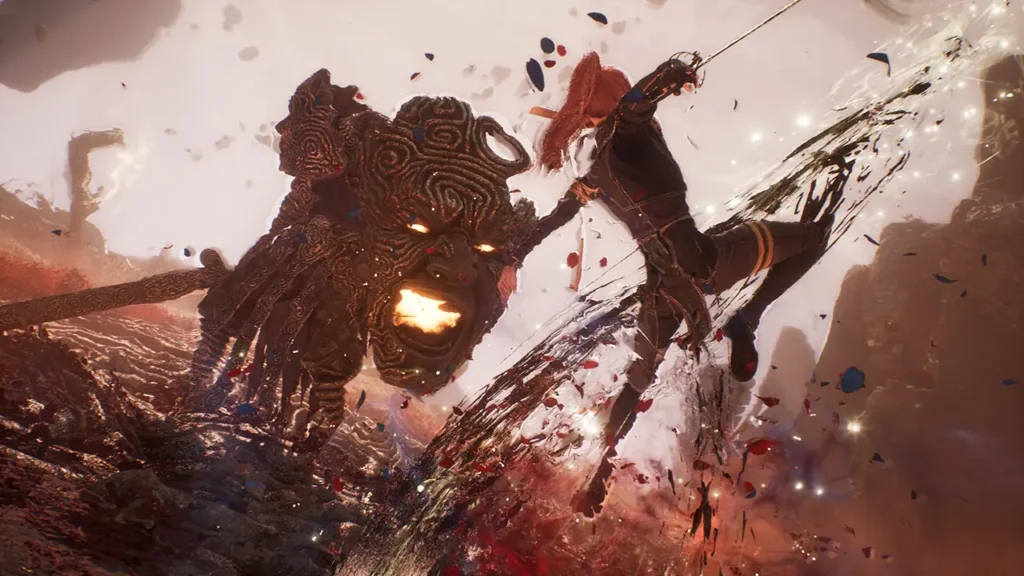
I also groaned a little each time the game tried to inject some jumping and platforming, because it was just incredibly clunky. I already mentioned the mini games at the beach, but there were certain zones that also required some precision jumping, and I don’t know, I when I missed a landing it felt more like an issue with the game than a skill issue.
But aside from than that, most of my complaints for the game are minor, like the invisible walls or an interface that can sometimes feel overwhelming. I was pretty deep into the game before I realized I could equip passive pictos in addition to the active ones, for example.
But none of those stop this game from being what I consider a true work of art.
Who’s This Game For?
So let’s talk about gamer types, because I love the gamer motivation model created by Quantic Foundry for seeing if this is something you’d jive with:

Using the Quantic Foundry gamer motivation model, here’s who should smash and who should pass:
- 🟢 For Action, this is about as action-y as you’ll get with a turn-based game.
- 🔴 This is not a Social game at all, unless you want to dig into the specific builds and show them off on Reddit or something.
- 🟢 There is a TON of Mastery to work with here.
- 🟢 I’d say it scores high on Achievement, too, because there are lots of collectibles, side quests, and by the end of it your characters are in a whole different league of power and abilities.
- 🟢 This game is off the charts on Immersion.
- 🟠 And lastly I’d say the game scores somewhere in the middle on letting you use your Creative side. There’s a lot of tinkering available in your character builds, and you can customize your characters with a variety of cosmetics.
The Art of a Great Game
Jerry Holkins of Penny Arcade fame once asked “how can something made entirely of art not be art?” He was referring to an old debate about whether or not video games were actually art. I don’t think that debate exists anymore, but this game reminded me of that idea of something being made up entirely of art.
The setting, the soundtrack, the story, and oh yeah that kick-ass combat system… it all adds up to a really unforgettable experience. I know that sounds like hyperbole, and it’s not gonna resonate with every single person, but damn. This game was fun from the beginning, I always wanted to know what was gonna happen next, and when it was over I had a lot to think about.
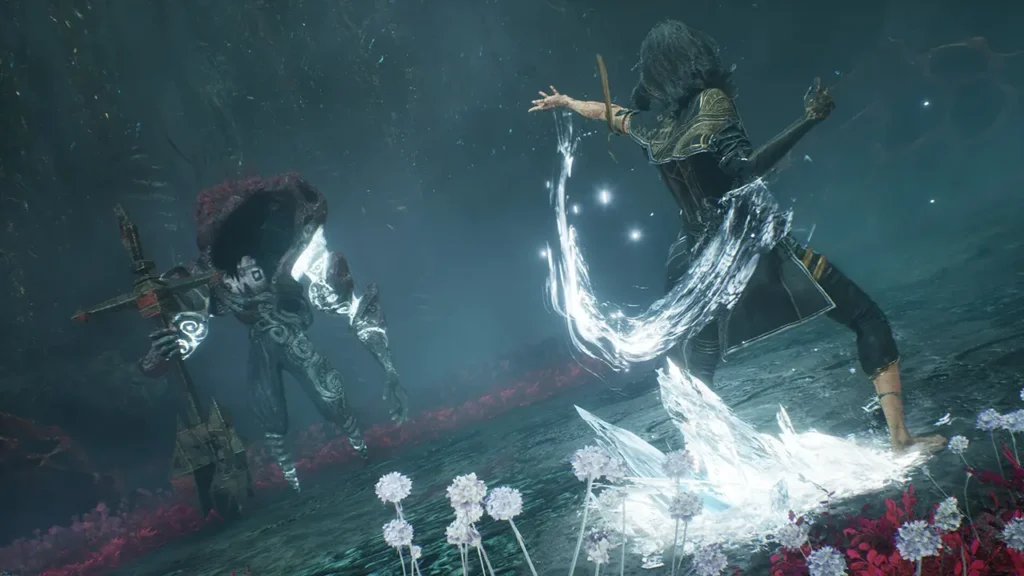
Clair Obscur: Expedition 33 blew me away. The game’s theme of extreme light and dark is more than just a vibe. That contrast is everywhere: in the visuals, in the characters, in the choices you make. It’s a game about beauty and sorrow, hope and loss, and the thin, blurry line that separates them. It’s not just a great game—it’s one that sticks with you.
It feels trite to say I give this game a thumbs up, which I do. What I really need now is some therapy. I’ll see ya in the next game. 👍
